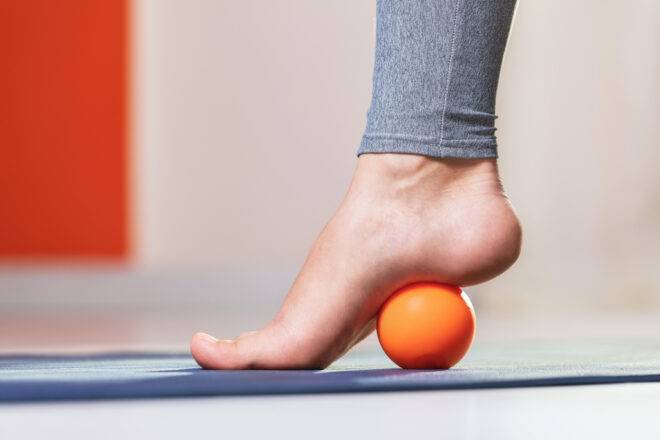Do you feel pain in your heels the morning after a run? In this case, you may have plantar fasciitis.
Plantar fasciitis is a common orthopedic condition that affects more than 1 million people annually. While it can affect anyone, it’s among the most common running injuries.
Excessive running is one of the risk factors, and this condition can occur predominantly among long-distance or marathon runners. This is why it’s sometimes called runner’s heel.
Read on to learn more about this condition and its causes, how far you can push yourself if you have it, and discover tips for better managing it.
In This Article:
What Is Plantar Fasciitis?
Plantar fasciitis is heel pain caused by straining the ligament connecting your heel to the front of your foot, the plantar fascia.
The plantar fascia consists of three bands made of the protein collagen, which is not very good at stretching. In the skin, it’s the protein elastin that combines with it to allow it to stretch without easily tearing.
Running too much too fast, wearing bad running shoes, and other factors can cause small tears in the plantar fascia. This is what causes the heel pain associated with plantar fasciitis.
The condition typically goes away on its own with adequate rest. But in some cases, the pain can continue for months.
Symptoms of Plantar Fasciitis
What does plantar fasciitis feel like? Here are the key symptoms associated with the condition:
- Severe heel pain in the morning or after rest, which usually gets better when you walk
- Dull or sharp pain at the bottom of your heel and along the foot arch
- Pain in the mid-foot area
- Tenderness in the heel area
- Pain when pushing your foot off the ground
- Hobbling when you get down from the bed in the morning
- Recurring pain after sitting still for a long period
In most cases, the pain develops gradually and worsens after running or other physical activity. Simple walking may make the pain temporarily go away.
What Causes Plantar Fasciitis?
The main cause of plantar fasciitis in runners is repetitive strain injury to the plantar fascia. This may be coupled with bad running shoes, having a poor ankle range of motion, and being overweight, which puts more strain on the ligament at the sole of your foot.
The clinical doctrine states that the cause of plantar fasciitis is degenerative irritation of the ligament. But more recent research casts doubt on this belief. Free radicals or metabolic and vascular disturbances could be potential causes.
Well-established risk factors of plantar fasciitis include:
- Obesity
- Having high-arched feet or flat feet
- Having a shorter Achilles tendon
- Having tight calf muscles and/or weak foot muscles
- Overpronating or feet rolling inward as you move
- Wearing bad running shoes
- Running on a hard surface
- Not warming up and stretching before running
- Having a bad running stride and cadence
- Suddenly increasing your running mileage
Running With Plantar Fasciitis
You can run with plantar fasciitis if you’re dealing with mild to moderate pain.
Managing the condition is easier if you have good leg and calf muscles and a workout plan with adequate warm-up and stretching exercises – more about this in a bit.
Just as important when you have plantar fasciitis is to address the condition even as you keep running with it. This means looking for ways to treat and prevent it.
Ignoring mild to moderate plantar fasciitis can increase pain and lead to the development of a chronic condition that can sideline you and that may require surgical treatment.
In beginners, plantar fasciitis can be caused by poor ankle mobility and weak muscles. Improving these will make managing it easier.
A study found a strong link between calf tightness and the severity of plantar fasciitis pain. The main cause of calf tightness in runners is running too much or training too hard.
In the case of experienced runners, the cause can be too much strain. It may call for more rest and lowering your running goals until recovery.
Important: Whether you’re a new or seasoned runner, when you have plantar fasciitis, you don’t want to run more or train harder until the condition improves.
8 Tips to Run With Plantar Fasciitis
Plantar fasciitis doesn’t have to keep you on the couch in front of the TV. In most cases, the condition is manageable.
Before we look at ways to keep running with plantar fasciitis, remember that preventing it is always better than having to manage it.
The good news is that there are plenty of things that even people who are anatomically predisposed to this condition can do to mitigate the risk.
Here’s how to run with plantar fasciitis as well as reduce your risk of developing the condition in the first place.
1. Stretch regularly
Over 98% of people with plantar fasciitis get better without surgery. But the condition still requires adequate management, and working on your ankle mobility is one of the best ways to start.
The best exercises for plantar fasciitis for most runners are toe stretches and flexing your foot before standing.
For best results, follow a daily stretching regimen that combines standing calves stretching exercises that bend your knee and seated stretching exercises that bend your big toe. You can repeat each for 30 seconds up to three times a day.
Tip: Cool-down stretches are just as important, so don’t forget to do them!
2. Warm up
Warming up properly before running is crucial to both preventing and managing plantar fasciitis.
Add to your warm-up routine dynamic stretches, calf raises, and ankle circles. Pointing and flexing your toes is another good warm-up exercise.
A study on Achilles tendinopathy found that runners could continue to train if they managed to keep the pain from their injury midway between 0 (no pain) and 10 (worst imaginable pain). This approach reduced pain by the following morning. A similar approach may also be effective for plantar fasciitis.
But bear in mind that if you have chronic plantar fasciitis, research indicates that stretching the plantar fascia is more effective than stretching the Achilles tendon.
3. Get the best running shoes for runners with plantar fasciitis
You want to use running shoes that provide support as well as cushioning. It’s important to avoid minimalist shoes with a thin sole and go instead for a good cushioning shoe. Look for a deep heel cup and firm heel support.
Shoes that provide arch support for plantar fasciitis can also help protect you from other common running injuries.
4. Rest regularly
As with all running injuries, regular rest will give your body the time it needs to recover. This includes both rest days and resting when running by switching to walking mode.
How much you rest depends on how serious your injury is and your training goals. But in general, you want to rest more than usual in the weeks following the first symptoms of pain. Listen to your body.
Unless the pain is intense, stopping altogether during a run may make you feel the pain more acutely as your body cools off. You may want to switch to walking instead.
Tip: Follow the general rule for reducing the risk of running injuries – increase the length or intensity of your runs and training by no more than 10% every week. But if you already have plantar fasciitis, put off the increase until the injury heals or becomes easy to manage.
5. Put ice after each run
Before you apply ice, make sure you do cool-down stretches. You can use bags or packs of crushed ice or an ice bottle. For plantar fasciitis, an ice bottle is often better as it allows you to massage the affected area.
Sit on a chair and place the ice bottle under your injured foot. Using your foot, roll it back and forth for 10 minutes. During this massage, you want to apply moderate pressure on the arch of your foot.
Tip: You can also use the ice bottle for morning massages the day after your run.
6. Tap your feet
Arch taping reduces the amount of stretching the plantar fascia has to do when you move. According to research, arch taping is a good way to reduce short-term plantar fasciitis pain.
You’ll need zinc oxide tape, a type of athletic tape. Apply it around the ball of your foot, and then add strips around your heel and the back of your heel. Cover the sole of your foot with smaller pieces.
Wear it during and after runs or while you’re resting.
7. Wear night splints
Studies show that wearing night splints can also help you deal with the symptoms of plantar fasciitis. A night splint works by preventing the fascia from becoming tighter during the night, reducing pain in the morning.
Consider getting one that fits you well and wear it during the night. You may especially want to use a night splint if your plantar fascia pain is worse in the morning.
8. Use orthotic inserts for plantar fasciitis
Last but not least, try orthotic inserts that reduce the strain on your plantar fascia when you move. These essentially support the foot arch and improve alignment.
Custom orthodontics can be quite pricey, and there’s no solid body of evidence to suggest they are much better than premade ones.
What Is the Best Treatment for Plantar Fasciitis?
The fastest way to cure plantar fasciitis is rest. This doesn’t have to mean stopping running altogether but taking it easier until your body tells you that you can switch gears.
Plantar fasciitis tends to resolve on its own without treatment within 6–18 months. The tips we shared with you above can help your plantar fascia recover while you keep running.
Having patience is important as there is no overnight treatment that will magically cure the condition. Try also to address any risk factors you may have.
Key Takeaways
If your plantar fasciitis pain gets worse, doesn’t go away, or threatens to completely sideline you, you may need to consult with your doctor.
Depending on your condition, your doctor may prescribe complete rest and anti-inflammatory drugs, including iontophoresis and cortisone. Surgery is typically a last resort that very few runners will need.
When plantar fasciitis is painful enough to interfere with your training, you want to stop running for 3–5 days to give your body the time to rest.
During this period, you can stretch and do other exercises or rest completely, depending on how bad the pain is.
In the end, plantar fasciitis is much more likely to annoy you than to thwart your running goals. Yes, you’ll likely have to rest and take it easier for a time.
But often, this is an opportunity to improve your workout and running gear that can prevent running injuries in the future and keep you running for longer.














